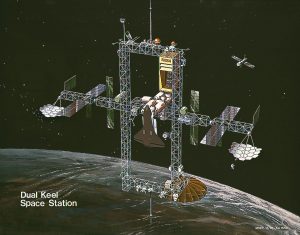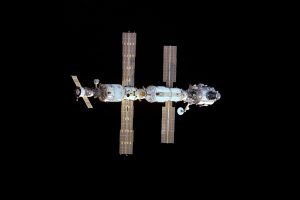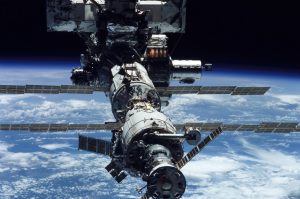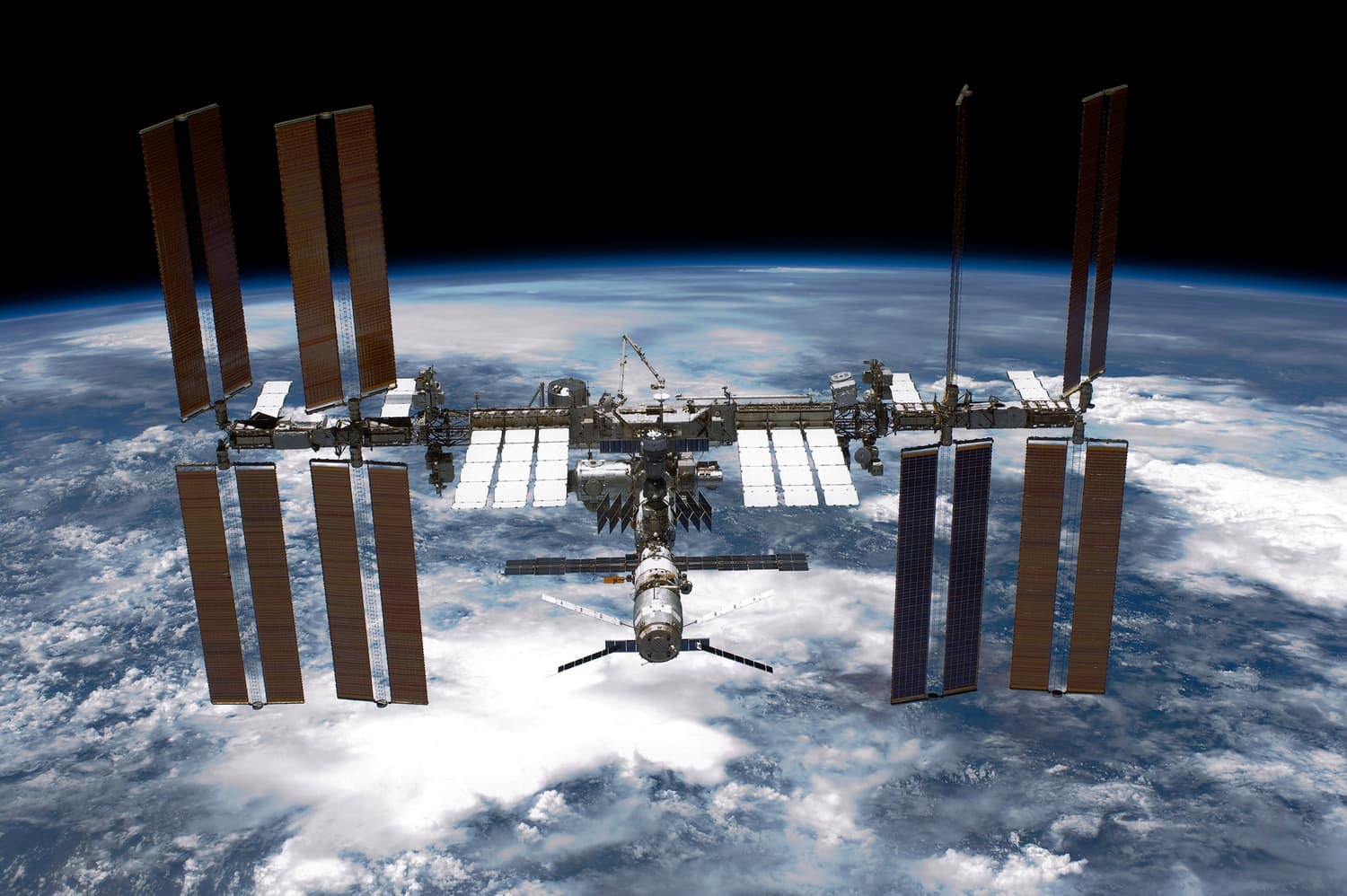Today is a special anniversary for me (and, well, OK, sure: NASA too).
In 1984, President Ronald Reagan announced the U.S. would build a space station. NASA started gearing up, with various chunks of the project assigned to or adopted by various NASA centers. Despite being known as the center for unmanned space probes, the Jet Propulsion Laboratory took on parts of the project work.
In 1986, JPL was assigned by NASA headquarters to create an introductory “user manual” for scientists who wanted to fly experiments on the station: what sort of power supply could they get? Was water available? How about a freezer? What would the microgravity environment be like? Can we attach something to the outside? It went on and on.

And I, as a recent journalism school graduate with a specialty in science writing — and a knack for explaining complex topics to those outside the field — was the guy hired to research and write the document. I started at JPL in September 1986. The project boss handed me a gigantic stack of documents related to work on the space station so far, and told me to read through them to “get familiar” with the project.
Wait… I get paid to read a bunch of geeky space stuff? My kind of job!
The design was grand …and budgeted at $8 billion. The dollar figure and the timeline were thought to be rather ambitious. Later, NASA tried to push things along with the slogan, “Faster, Better, Cheaper.” (Which led to a joke in high circulation at JPL: “Faster, Better, Cheaper: pick any two.”)
Every time I finished a draft and sent it to headquarters to review, there would be a weeks to months pause as they looked it over, and the message back would be along the lines of, “Looks great! But we have a new baseline [design] coming, so when that comes out, update it with the new info.”
That happened again and again and again …until my boss gave me an interesting task: take all the materials to the sponsor in Washington D.C., hand it to him, and say we resign from the handbook project — and get him to agree to let us keep the funds in the account for other tasks. I didn’t think the sponsor would agree, but he agreed to it all, and I moved on to other things at JPL.
Historical Steps
In addition to being the stuff of science fiction for decades, one of the biggest proponent of getting the U.S. into space was Werner von Braun. Sure, he was a member of the Nazi party when working on rockets for Hitler, but he didn’t really care about the politics: he just wanted to move humanity into space, and it didn’t matter to him who paid for it. So after WWII he happily joined the United States’ efforts.
Von Braun envisioned a nuclear-powered station with artificial gravity housing “50 men.” The above is a clip from Man in Space*, one of a series of three films produced by Disney(!), and first aired on March 9, 1955, as part of their Disneyland series (later Walt Disney’s Wonderful World of Color). After seeing it on TV, President Dwight D. Eisenhower asked for a copy to show to the Pentagon’s “rocket experts.” It was nominated for an Emmy award for Best Documentary Short. The model shown here has been on long-term loan to the National Air and Space Museum.
But wait: why would a science outpost have artificial gravity? Well, that’s not what the scientists really had in mind: they wanted “zero” gravity (really, microgravity), since that’s the only place they could get it.
So this is one of the baselines of what we were really planning to build:

Reagan decreed in 1987 the station would be named Freedom as a bit of a dig at the Russians: their Mir space station was launched in 1986: the word means “Peace.”
Despite “Faster, Better, Cheaper,” by the time I left NASA in 1996 to work on This is True full time, station construction was still years from construction starting. Along the way “Freedom” changed to “Alpha” (1993) and, when cost estimates continued to climb, we came to agreement with Russia (who abandoned their Mir-2 concepts), the European Space Agency, Japan’s NASDA, and the Canadian Space Agency, which came together to contribute to the “International Space Station” — which name has stuck.
The Anniversary
The first launch in the ISS’s construction was 20 November 1998: the Russian module Zarya. It took two more years of launches and assembly missions before it could be permanently inhabited, but that finally happened on 2 November 2000 — 20 years ago today.
The three-man crew of “Expedition 1” stayed 136 days, arriving via a Russian Soyuz spacecraft. During that time, three shuttle missions brought supplies — and very welcome visitors.
It has had humans onboard continuously since then.
Here’s what it looked like in December 2000. Even after two years of work, it was still pretty bare bones:

When Endeavour (STS-111) visited again after two more years of deliveries and construction work, it wasn’t all that much bigger:

Today
The station has been continuously manned (and womaned!) for 20 years as of today.
The station is very easy to see on a clear night, if it happens to pass over your location. It’s large, and the brightest moving thing in the sky — and moving fast — it generally only takes 6-8 minutes to go from horizon to horizon. Every time I see it I think to myself, “There are people in there” (and say that out loud to anyone who happens to be nearby, and hasn’t heard me say it before). NASA makes it easy with a web site to tell you how to see it.

And they’re looking back: when there are no other programs running on NASA TV, the channel usually shows a live video feed of Earth from the station.
I’m proud to have been a minuscule part of the program, even if it didn’t get off the ground during my literal tenure at the Jet Propulsion Laboratory. But the station is not an end product: it’s a stepping stone as we venture into space: at some point humanity’s “continual presence in space” won’t be a mere 250 miles from home.
*Addendum: Man in Space (discussed above as the first of three Disney films about space, which had Werner von Braun as a technical advisor and participant) is actually available to stream on Disney+. So is the third in the series, Mars and Beyond, first aired in 1957. What they don’t have available is the middle episode, Man and the Moon — and my source was wrong about which episode the above clip is from. It’s from the second, also from 1955, which isn’t available on Disney+. (Source for details on the episode: NASA/MSFC.)
Related Post: Behind the Scenes at JPL
Further Reading: How the Space Station Became a Base to Launch Humanity’s Future (New York Times)
– – –
Bad link? Broken image? Other problem on this page? Use the Help button lower right, and thanks.
This page is an example of my style of “Thought-Provoking Entertainment”. This is True is an email newsletter that uses “weird news” as a vehicle to explore the human condition in an entertaining way. If that sounds good, click here to open a subscribe form.
To really support This is True, you’re invited to sign up for a subscription to the much-expanded “Premium” edition:
Q: Why would I want to pay more than the minimum rate?
A: To support the publication to help it thrive and stay online: this kind of support means less future need for price increases (and smaller increases when they do happen), which enables more people to upgrade. This option was requested by existing Premium subscribers.

I’m reading deGrasse Tyson’s Accessory to War at the moment, which of course intertwines NASA with his profession. I’d be interested in a blog on same at some point … not tonight though!
I truly *hope* that “at some point humanity’s ‘continual presence in space’ won’t be a mere 250 miles from home” comes true in my lifetime. Having watched the 1st humans to step onto the Moon *LIVE*, and then living long enough to watch the 1st humans to step onto the surface of some other object in our solar system, Mars being the most likely — now *THAT* would be great! Almost as good as having been at the Wright Brothers 1st flight & living long enough to watch the 1st humans to step onto the Moon (which was quite possible since the 2 events were less than 66 years apart).
Though the way 2020 has been going, I’d be happy with just surviving the rest of the year without anything else horrible happening!
—
My grandmother didn’t witness the first flight, but remembered it from news coverage at the time — and saw the moon landing. Amazing progress, and I also hope to be alive to see that first step on another planet: I also watched the moon landing and first step live. -rc
Amazing. I saw one of your manuals. I couldn’t put it down. A friend at Texas Instruments showed a copy to me. So you have been writing interesting topics for years…I should have known. Thank you.
—
Was it one of the “Space Station Utilization Team” study reports? There were a bunch of those, and they circulated fairly widely. I was the editor and publisher for the entire series. -rc
Congratulations, Randy. You have every right to be VERY proud of your contributions to the ISS.
As someone whose grandmother traveled from Arkansas to Oklahoma in a covered wagon around 1913, it is beyond amazing to consider she also saw men land on the moon just 5 decades later and that her granddaughter will likely see a human go to Mars.
1987 you had a window AND a printer at your desk! Dang that was huge. Let me guess that was an orange not a green screen too. Great to see that our wardrobe has progressed beyond Polo shirts and Khaki pants in 20 years.
While it’s great to look back your ‘True’ success comes from your weekly outreach program to ensure that we never forget to use our uncommon sense.
—
It might even have been VGA! I actually don’t remember. It was the transition from XT to AT days. The printer is dot-matrix. I was later the only one in the building that had Windows and Mac, and laser printers for each. It made me the go-to guy for some time! 😀 -rc
Hah! Now I get to wax nostalgic with you. Started at NASA Ames Research Center in July 1986. Worked for 10 years with some of those people that wanted to do science in the ISS. Did not happen since the money went away. Although, one piece of hardware with requirements that I “owned” did make it to the ISS.
I watch that bright dot cross the sky. I tell as many people as possible about it. When we get a bright crossing, 3 hours later a similar thing happens 3000 miles away over a lot of my relatives in CA. I let them know about it.
Yes, I did watch the moon landings live, and am eager to see people go back, but that whole distance thing keeps me from desiring anyone on Mars. A 7-9 no gravity month ride followed by either 14 days or 500 days on the surface (pick one), followed by a 7-9 month ride does not sound like fun for anyone. Well, I guess if you do not want to come back to Earth, you can stay as long as you want.
I do miss our buddy Jawn. I am sure that the three of us would tell some stories. Thank you Arcie. I am having a happy smile because of you.
—
I met George at NASA in 1987, and we’ve been in touch ever since. -rc
I had the pleasure of touring the life size model of Freedom when I attended Space Camp in Huntsville Alabama in 1992. I have loved watching each change and advancement in the space program. So wonderful that it’s been 20 years since this accomplishment and it continues on.
Concerning naming; there’s a clip on Youtube (somewhere; I’ve lost the bookmark) of Expedition 1’s commander giving an inaugural speech *from the station* and calling it “Alpha”; the people in Space Hipsters on Facebook tell me there was a fair amount of politics involved in that title dropping away, but no one will quite say what.
We’re most of a year past the original planned splash date for the Station, in 2020; it’s been pushed to 2024, I’m told.
Do you have any reaction to that topic, as someone who worked on it, however tenuously?
—
While it’s a bit unclear which topic you mean, NASA archives note (emphasis added): “Over time, each proposed station and alternative version in turn failed to gain acceptance and budget approval, and was dropped during re-scoping and down-sizing of the plan. Those rejected items included Space Station Alpha and Space Station Freedom, the last of the group.”
Russia objected to the name, since they say Mir was the first space station. But Skylab counts in my book (and NASA’s: it’s the subtitle of a 1977 history), since it was an orbiting platform that was manned by multiple crews over several years.
The first station commander, astronaut Bill Shepherd, brought the Alpha idea back, but it wasn’t in a speech. On the first day of his command, he had a space-to-ground call with then NASA Administrator Dan Goldin, which was broadcast live to the public (probably what you saw). Shepherd said, “The first expedition on the space station requests permission to take the radio call sign Alpha.”
Goldin paused for several moments and replied that “Station Alpha” was authorized for the term of Shepherd’s command, which is quite a bit different from officially naming the station Alpha. Seems to me the proper designation is Gamma. -rc
The call you mention is probably what I heard, but I remember it as a pronouncement, not a request. I see that the language you quote is all over the web, so clearly, I’m remembering it wrong.
But the thing I was asking for an opinion on is “let’s splash our $350B space station in 4 more years”….
—
I doubt that will happen. I think that either funding will be extended, or it will be turned over to commercial operations. -rc
I get the “Spot the Station” emails and often go outside to watch it pass over my house. And I always marvel that there are people living up there.
When I was in the Air Force, circa 1995, one of the projects I worked on was an (external) VR model of the planned Freedom. It wasn’t really part of our VR research, but it was popular with the visiting generals. The lab planners were careful to have our shop be the last office on the tour, because VR was the carrot to get the generals to watch the rest of the research demos.